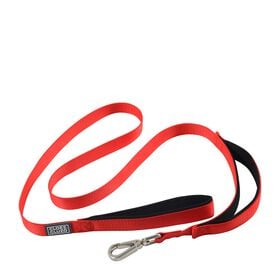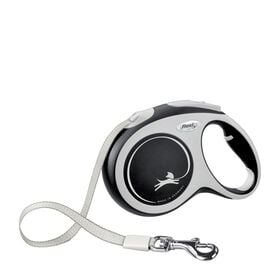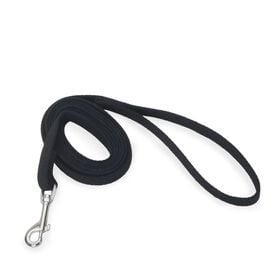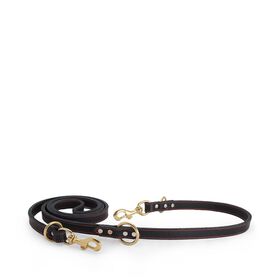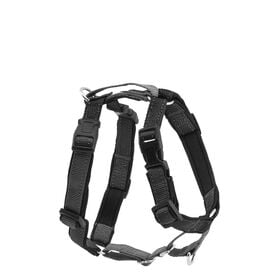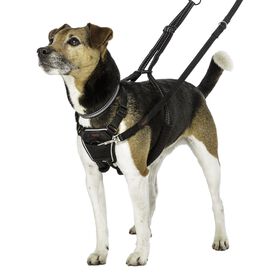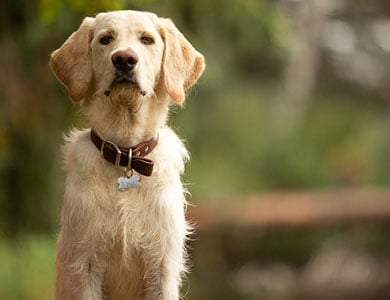
Learning all about the features and benefits of a product for your pet is important, but even more so when it's something your pet will wear because you'll want to choose the most comfortable and effective product available. The following is a simple description of the various options available for your pet to help you make an informed decision.
A collar is essential for attaching a dog tag and for quick outings. The following are a few points to consider when making your choice.
Material: fabric, leather or silicone (to be determined on the basis of your dog's comfort and skin sensitivity, and use)
Width: 1.2 cm to 1.9 cm or 2.5 cm (½ to ¾ in. or 1 in.) wide (to be determined on the basis of your dog's size)
Size: manufacturers often have collar models that range from very small to very large. Most of the time, collars range from 15 to 63.5 cm (6 to 25 in.) (depending on the size of your dog's neck).
Isabelle Borremans' favourite collar
|
Collars
|
Advantages
|
Points to consider
|
|
Clip collar
|
- Wide range of models
- Model available for very small dogs
|
- Since this type of collar is more widely available, it's often of poorer quality
|
|
Collar with holes
|
- More precise and quicker adjustment because of preset holes
|
- If you have to put on and take off the collar regularly, this type of fastener is less practical
|
|
Martingale collar
|
- Ideal for dogs with a head and neck of comparable width (e.g., greyhound)
|
- Not that easy to adjust and more expensive and harder to find
|
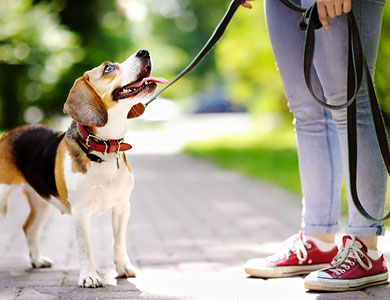
Choosing a leash is very important because it connects you to your dog. The following are a few points to consider.
Length: 1.2 to 1.8 m (4 to 6 ft.) (to be determined according to the size of your dog)
Material: silicone, fabric, leather (to be determined on the basis of use)
Width: 1.2 to 1.9 cm or 2.5 cm (½ to ¾ in. or 1 in.) wide (to be determined according to the size of your dog)
Isabelle Borremans' favourite leash
|
Leashes
|
Advantages
|
Points to consider
|
|
Single or double leash
|
- Most common because it's easy to use and can be attached quickly
- Available in a variety of colours and fabrics
|
- Once again, when a product is available in large quantities, you have to be sure to find the right quality to avoid being disappointed
|
|
Multipurpose leash
|
- Allows you to attach the leash to your waist or wear it over your shoulder, and create a handle that suits you and that sometimes has an extra attachment to better manage your dog
|
- A little more expensive than a single leash
- It's important to try the leash on site to be sure that it can be adjusted to suit your needs and is long enough for your dog if you attach the leash to your waist or wear it over your shoulder
|
|
Bungee leash
|
- A good shock absorbing option if you enjoy brisk walks with your dog
|
- More difficult to find for small dogs (under 9 kg or 20 lbs)
|
|
Safety leash
|
- A universal leash that allows you to attach your dog, with its harness, to your car's seat belt buckle
|
- Restricts your dog's movements, but has not been crash tested
- Requires access to an available seat belt buckle
|
|
Retractable leash
|
- Ideal for walking in open spaces where you can't let your dog off leash
|
- To avoid injuring your pet or a passerby, not recommended for a walk through your neighbourhood or the city
|
|
Chain leash
|
- A good temporary choice if you have a young dog that tends to chew on its leash
|
- Uncomfortable and heavy; recommended only for short-term use
|
|
Training leash
|
- Often called a tether, it's useful for dog instruction
|
- Use outside and in open spaces to prevent tangling
|
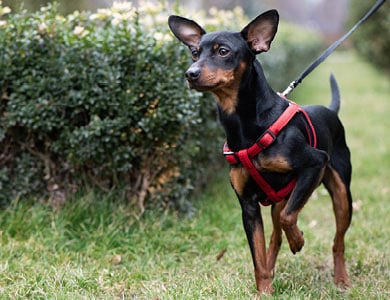
A harness is the best tool for your dog. When choosing a harness, it's important to consider your dog's comfort, but also how you plan to use it.
You may very likely decide on one model of harness for walking and another for hiking or running. Your dog will learn to tell them apart and know when it's time to explore, or go for a walk or a run with you.
Isabelle Borremans' favourite harness
|
Harnesses
|
Advantages
|
Points to consider
|
|
Back-clip harness (that allows you to attach the leash to the middle of the back)
|
- Can be found anywhere and is ideal for calm dogs that don't pull
- Very popular, so easy to find for all types of dogs
- Ideal for growing puppies, since it's often inexpensive
|
- It's always recommended that you try 2 or 3 different harnesses before choosing one. Take the following criteria into account: dog's comfort, quality of the material, and ability to put on and take off easily
|
|
Front-clip harness (that allows you to attach the leash to the chest, between the shoulders)
|
- Often copied but never equalled, a good front-clip harness is ideal for a dog that tends to pull
- Often has another clip at the back (for when the dog isn't pulling) and even a handle to help you easily hold back the dog
|
- An increasing number of models offer this innovation, but it's important to carefully test it on your dog beforehand to assess the product quality
|
|
Head harness
|
- It's not a muzzle, but a harness that allows you to manage your dog during unpleasant walks
- Very effective and allows you to control your dog's tiniest movements without having to use force
|
- Tool that requires considerable adaptation, both for the owner (to make sure it's on correctly) and the dog (to gradually get used to it)
- It should be used gradually and may take the dog a few days or weeks to adapt
|
|
Running harness
|
- A more specific model that allows your dog to run as though it weren't wearing anything at all
- Since canicross is becoming an increasingly popular sport, there is a greater choice of products available
|
- To use it correctly, you should also budget for a waist belt, so you can run with your dog, and a bungee leash that attaches to the running harness and belt, to avoid falls
|
|
Car harness
|
- An essential item for car travel
- Although some models are designed specifically for your car, other types of harnesses for your daily walks can also be used as car harnesses (read the manufacturer's instructions)
|
- Unfortunately, few models have been crash tested
- You have to budget a considerable amount for a crash-tested model
- Since safety is a priority, take the time to carefully read the instruction manual and get used to the different harness straps
|
|
Hiking harness
|
- Generally has storage pouches for your dog's gear, such as poop bags and a collapsible water bowl
- Less restrictive and allows the dog to be more relaxed on the hike
|
- Not suitable for everyday use and can be restrictive
- Generally more costly
- Requires patience at first because several features have to be adjusted to prevent the harness from becoming uncomfortable
|
The best options for your faithful companion :





